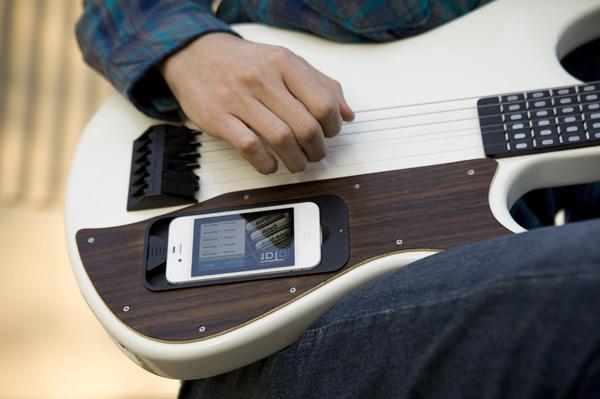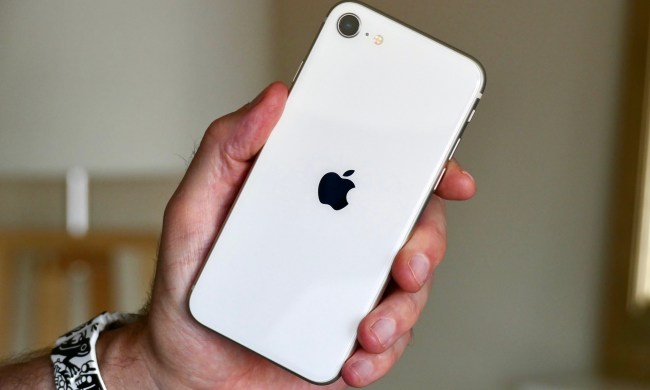
Kickstarter has a new blockbuster project. Dubbed the gTar, this iPhone-controlled electric guitar promises to make learning to play a breeze by offering users light-up fret guides, and a variety of difficulty levels. The invention has proven so appealing that the gTar, created by Incentive, has rocketed past its $100,000 goal in less than 24 hours after its launch on Kickstarter.
At the time of publishing, gTar has raised more than $159,800 from 427 backers. That number will be entirely different by the time you read this, however, as it is changing nearly every minute. We would be surprised if the gTar doesn’t break $200,000 by the end of Wednesday — and that will still leave more than 30 days left of funding to go. The only other Kickstarter project to receive such instant, overwhelming success is the Pebble smartwatch, which recently topped out at just over $10 million, making it the most well-funded Kickstarter project in the site’s history.
Josh Stansfield, one of Incentive’s five-person team, and the company’s key marketing person (among other things), says that the company plans to use the additional funds to jumpstart their business — and, of course, make and ship guitars to the hundreds of people who have essentially pre-ordered one by donating to the Kickstarter project.
“Nearly all the funds will be spent on manufacturing and related costs — while our goal has been surpassed, that also means we’ve committed to shipping more gTars, and those cost more money,” said Stansfield in an email with Digital Trends.
As with so many popular electronic devices, the key to gTar’s is its simplicity. Rather than connect to a separate amplifier, the gTar’s sound comes directly out of the user’s iPhone, which docks directly into the body of the guitar. Using an accompanying app, users can choose from a number of different modes and difficulty levels.
The gTar’s light-up fret board shows users where to place their fingers on the strings as they play along to songs loaded into the app. In Easy and Medium mode, the gTar helps users move through a song by enabling only the correct notes using the app’s “Smart Play” technology. The Hard mode shows users where to place their fingers, but gives them the ability to play whatever they like. The app also allows a freestyle mode, which lets users play their own tunes, and add light displays to their performances using the fret board.
Incentive says on its Kickstarter page that the free gTar app will come pre-bundled with a number of songs that will work with the gTar. The company also plans to add more songs “every week.” Those who pledge money to the Kickstarter campaign can request to have their favorite songs added to the lineup.
Incentive says that, because the gTar “grew out of a series of hacks,” they plan to make the device developer and musician friendly. An SDK will be made available to interested devs in the future. And the gTar will come USB-MIDI compliant, making it easy for musicians to incorporate the gTar into their electronic instrument repertoire.
Of course, the primary downside to the gTar at the moment is that only the iPhone 4/4S works with the device. That will change eventually, says Stansfield, but the Incentive team wants to focus on making the original design work well before putting in money and time to allow for a wider range of devices.
“While we’d love to support all kinds of smartphones and similar devices, we will not be supporting other platforms in this short-term,” says Stanfield. “It’s not so much a limitation of funds as it is our time and ability to ensure that everybody who uses the gTar has a great experience with it.”

We haven’t yet had a chance to get our hands on a gTar just yet, but from what we can tell, this is a huge step forward in electric guitar technology, at least for casual and beginner users. And though Stansfield says that he doesn’t believe a device like the gTar will ever replace traditional guitars, it does provide a valuable tool for those looking to create quality electronic music.
“We don’t believe that electric guitars could ever be replaced — there are still unique characteristics that make them interesting to people and we don’t see that going away anytime soon,” says Stanfield. “However, as we’ve seen in the last 10+ years, music made on a computer can be just as compelling and emotionally satisfying as music made on acoustic instruments. If instruments that utilize this technology can help more people experience the joy of playing music who wouldn’t be able to otherwise, we certainly think they will become more popular.”
Those of you interested can pledge $399 or more to the gTar Kickstarter project. For that amount, you’ll be one of the first to receive the white gTar.
Watch the gTar Kickstarter promotional video below


